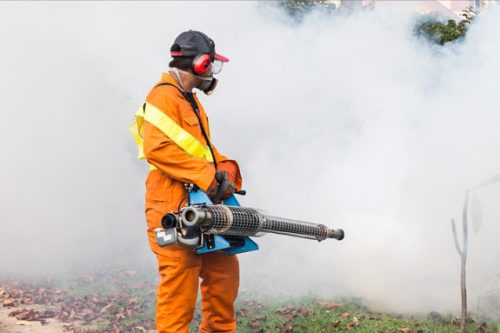Seasonal Pest Control Tips for Texas Homeowners: A Comprehensive Guide
To keep pests at bay throughout the year in Texas, start by sealing any cracks and crevices in your home, especially around doors and windows. Additionally, regularly trim vegetation around your property and eliminate standing water to deter mosquitoes and other pests. Conducting routine inspections and partnering with a professional pest control service for preventative treatments can help safeguard your home against seasonal pest invasions.
Seasonal Pest Control Tips: A Texas Homeowner’s Guide
Being a homeowner in Texas means contending with a unique set of pest challenges. The ever-changing weather and diverse landscape create an environment that pest critters just love! From mosquitoes and termites in the hot, sticky summer months to rodents and spiders seeking shelter during the cooler winter, it’s a year-round battle to keep these uninvited guests at bay.
In the spring, when flowers fill the air with their sweet scent, pests like mosquitoes and ants start coming out from hiding to join in on nature’s symphony. That means getting rid of any standing water around your home and sealing up any cracks or crevices where ants might get in will be vital.
As summer kicks in full steam, it brings along blistering heat and a boom in termite activity. This is the time for vigilance against these destructive pests that can silently eat away at your home’s structure, causing extensive damage. For instance, scheduling a professional termite inspection before summer arrives can help prevent a lot of headaches down the line. It’s also wise to keep an eye on your home’s exterior wood for any telltale signs of termite infestation while keeping all wooden structures well-ventilated to prevent moisture buildup that attracts termites.
Moving into fall, temperatures begin to cool, but this doesn’t mean pests are packing their bags and leaving. Oh no! In fact, as outdoor conditions become less hospitable, many critters look for cozier accommodations indoors. That’s right – spiders, rodents, and cockroaches are just some of the unwelcome tenants seeking refuge from the dropping temperatures. Clearing away any debris around the perimeter of your home, sealing up entry points like gaps around windows and doors, and investing in regular pest control maintenance will go a long way in preventing these intruders from making themselves at home. To illustrate, introducing traps and regularly cleaning your home can deter mice and roaches from sticking around for too long. Additionally, outdoor lighting can attract fewer insects by selecting yellow or LED lights instead of traditional incandescent ones.
Lastly, as winter rolls around with chilly temperatures and unpredictable weather patterns, it becomes key to make sure pests aren’t using your warmth for their comfort. Stink bugs and ladybugs are known to seek shelter indoors during this time, so ensuring all entry points are sealed tight will help keep them outside where they belong.
Throughout the entire year, it’s important to stay proactive when it comes to pest control. By staying ahead of each season, you can keep those pesky creatures at bay and ensure your home remains a peaceful haven all year round.
Protocols for Handling Insects, Rodents and Wildlife
Dealing with pests is undoubtedly a challenge, but it’s a challenge we must face head-on. Here are some helpful protocols for managing these critters around our home without causing harm to them or the environment.
Pest Inspection
Think of it as detective work—we need to keep an eye out for clues that indicate pests might be nearby. This includes looking for droppings, gnaw marks, or any damage to structures. Regular inspections of our homes for these signs will help us catch problems early before they escalate. It’s like looking out for footprints to find where an animal has been.
If we can spot possible entry points and fix them quickly—whether it’s sealing cracks or gaps around windows and doors or fixing torn screens—that really helps too.
Did you know that pests can fit through tiny holes? It’s like how a sneaky mouse can fit through the tiniest crack in our kitchen wall! So, checking for and fixing those small entry points is super important.
Humane Removal
When wildlife intrudes, it’s important to ensure their safe and humane removal from our property. This means complying with local regulations surrounding wildlife and following ethical guidelines. We don’t want animals to suffer, so using traps that don’t hurt them as long as we release them far away from our homes is key here.
By being respectful to the animals around us, we create a healthier environment for everyone.
Conservation
We want to keep pests away without hurting our local ecosystem. That’s why adopting strategies like using natural repellents or planting pest-resistant vegetation is crucial. Using harsh chemicals might solve one problem, but they can create others. For example, some pesticides can hurt more than just the pests—we risk harming beneficial insects, birds, other wildlife, and even our pets. It’s like trying to fix a leaky faucet by smashing it with a hammer; there are gentler ways to solve the problem!
This could mean things like using cedar chips, which moths don’t like, instead of mothballs which are toxic. Or it could involve planting lemongrass to keep mosquitoes away instead of using chemical sprays that can harm other creatures too.
By taking steps to inspect our homes regularly, removing wildlife humanely, and using conservation-friendly strategies to deter pests, we become better stewards of our homes and surrounding environment.
Spring Pest Control Regime
As the days lengthen and the temperatures rise, spring signals the awakening of nature. It’s also the time when pests become more active, seeking out food, water, and shelter. This means it’s critical to take proactive steps to maintain a pest-free home during this season.
Addressing Breeding Grounds: One key element of your spring pest control regime should be addressing potential breeding grounds for pests. Start by inspecting your property for any standing water or areas where water collects. Clean gutters to prevent mosquito breeding and inspect leaks that may attract pests, as standing water can create an ideal environment for various pests to multiply.
Sealing Entry Points: With rising temperatures, wildlife and pests become more active in their search for food and shelter. Thoroughly inspect your property for cracks, gaps, or openings that might serve as entry points for pests. Promptly address them to prevent unwanted critters from making their way into your home. Sealing off potential entry points is a crucial step in pest prevention, ensuring that pests are kept out of your living spaces.
Just like repairing a leaky roof prevents water from entering your home during a rainstorm, sealing off entry points prevents pests from coming inside. It’s all about protecting your home from unwelcome guests!
Consistency is key when it comes to pest control. Keeping up with routine maintenance throughout the year will help minimize the chances of infestations and keep your home comfortable and pest-free. By addressing potential breeding grounds and sealing entry points during spring, you’re taking proactive steps toward maintaining a pest-free environment in your home.
Summer Pest Management Tips
As temperatures rise, so does the activity of pests seeking shelter and food. To keep these pests at bay, homeowners can take proactive measures to prevent infestations and maintain a comfortable, pest-free living environment. Here are some key strategies to consider when managing pests during the summer season.
Landscaping Practices
Maintaining the surrounding greenery plays a crucial role in managing pests around your home. Regular lawn mowing and trimming bushes help reduce harborage areas for pests such as rodents, ants, and other common insects. By keeping your lawn well-maintained and shrubs properly trimmed, you create an environment that is less inviting to pests looking for places to hide or build nests.
Additionally, consider removing any accumulated debris or clutter from your yard. Piles of wood, leaves, or unkempt vegetation can become breeding grounds for pests like termites or mosquitoes. Regularly clearing these areas reduces the likelihood of these pests finding their way into your home, ensuring a pest-free outdoor environment.
By implementing simple gardening and landscaping practices, Texas homeowners can significantly reduce the likelihood of pest infestations on their properties.
Air Circulation
During the summer months, improving ventilation inside your home is a valuable tool in minimizing humidity levels. Reduced humidity prevents conditions that are favorable for pest proliferation, especially for insects like ants and spiders. By allowing good air circulation through your home, you discourage pests from seeking refuge in dark, damp areas where they might establish nests or hiding spots.
Consider using fans or opening windows to facilitate airflow within your living spaces. Additionally, utilizing dehumidifiers in areas with excessive moisture content can keep indoor environments less conducive to pest activity. The key is to create an environment that is inhospitable to pest populations while maintaining comfort within your home.
These initiatives not only prevent infestations but also contribute to ongoing pest management efforts in maintaining a healthy living space throughout the summer months.
Fall Pest Control Measures
The change in seasons also brings about a change in the behavior of pests. As the weather cools, pests start seeking warmth and shelter, making your home an inviting target without proper precautions. It’s crucial to take a proactive approach to keep pests at bay during the seasonal transition.
Weather Stripping: One of the key measures is ensuring proper weather stripping on your doors and windows. As the temperatures drop, pests will look for potential openings for warmth. Poorly sealed doors and windows can provide an easy entry point. Regular inspection and repair of damaged or worn weather stripping can prevent pests from finding their way indoors.
Yard Maintenance: Regular yard upkeep, including clearing fallen leaves and debris, is vital to discourage pests from nesting around your property. Fallen leaves can become ideal hiding spots for pests seeking shelter as the weather gets cooler. By maintaining your yard well, you reduce potential nesting areas for pests, thereby minimizing their presence near your home.
It’s also important to trim back bushes and shrubs close to your home. Pests often use overgrown plants as bridges to gain access into the house, so trimming them back serves as a preventive measure against pest entry.
With these preparations in place, you can significantly reduce the chances of pests finding their way into your home as the weather transitions from summer to fall. Taking proactive steps now can save you a lot of hassle later on, ensuring a pest-free environment in the months ahead.
Incorporating these preventative measures into your fall routine not only protects your home but also ensures peace of mind as you transition into the colder months ahead.
Winter Pest Precautions
The cold weather signals pests to look for a warm place to call home, and that may very well be your house. So, make sure to take these actions to prevent pesky intruders from settling in.
Firewood Storage
Storing firewood near your house might seem convenient, especially during the winter when you need easy access to fuel your fireplace or wood stove. However, pests like ants, termites, and beetles often make their homes in firewood piles. To avoid introducing these unwanted guests into your home, store firewood at least 20 feet away from your house. Before bringing it indoors, inspect the firewood carefully for any pests and signs of infestation.
It’s better to be safe than sorry when it comes to keeping your home free of unwelcome visitors.
Sealing Cracks
During winter, rodents and insects seek warmth and shelter indoors, making it crucial to secure your home against potential entry points. Check for cracks and gaps in the foundation, walls, windows, and roof. These small openings are like an open invitation for pests seeking refuge from the cold.
For example, mice can squeeze through gaps as small as a dime, while insects can exploit even tinier openings. Seal these cracks using weather-stripping, silicone caulk, or other appropriate materials.
By taking preventative measures such as storing firewood away from your house and sealing cracks and gaps throughout your home, you’re creating an environment that is less attractive to pests. This diligence in preparation helps keep your household free of unwanted intruders.
It’s important to stay one step ahead of these potential problems with vigilance and regular inspection of key areas around your property.
Remaining proactive in safeguarding your home is essential for preventing pest infestations.
Comprehensive Pest Management for Texas Homes
In Texas, staying ahead of pest problems is all about being proactive. Regular inspections are a must-do to detect any signs of pest activity before it becomes a full-blown infestation. At Green Earth Exterminators, we emphasize the importance of having professional inspectors assess your property consistently. They have the training and experience to identify subtle signs of pest activity that may go unnoticed by homeowners.
Entrusting this responsibility to professionals ensures that your home is protected against a myriad of pests that can cause damage and pose health risks. With access to expert pest control services, you can rest assured that your home remains a safe and healthy environment for you and your family.
Customized treatment plans are crucial for effective pest control in Texas homes. Every home has its own set of unique pest challenges, and addressing them requires tailored solutions. Companies like Green Earth Exterminators understand this, which is why they provide customized treatment plans to cater to the specific needs of Texas homeowners.
For instance, a home in Houston might be more prone to termite infestations due to the warm climate, while a property in Austin might need specialized treatments for scorpion control. Each situation calls for a different approach, and having a provider who offers tailored solutions can make all the difference in preventing and eliminating pest problems effectively.
By partnering with a pest control provider that offers customized treatment plans, homeowners can address their unique pest challenges with precision. This targeted approach not only ensures effective pest control but also minimizes the use of pesticides, making it an eco-friendly option for homeowners who prioritize sustainability.
In the following sections, we’ll explore additional strategies for comprehensive pest management that will help Texas homeowners maintain a pest-free environment year-round.
Safeguarding your home against pests should not just be reactive but proactive. Regular professional inspections and tailored treatment plans are key steps for protecting your home. By working with experts like Green Earth Exterminators, you can ensure an environmentally conscious and effective approach to pest management.




